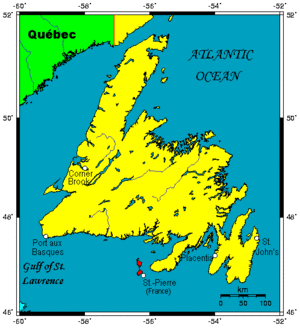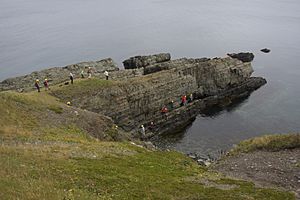Fortune Head facts for kids
Fortune Head is a special place on the coast of Newfoundland, Canada. It's a headland, which is a piece of land that sticks out into the ocean. It's about 1.6 kilometers from the town of Fortune on the Burin Peninsula.
This area is famous because it has a very important section of rock layers. These layers are about 140 meters thick and show a major point in Earth's history. This spot is called a Global Boundary Stratotype Section and Point (GSSP). Think of it like a special marker in the Earth's timeline! It shows the exact boundary between the Precambrian era and the Cambrian period. This was about 541 million years ago. Fortune Head was chosen in 1992 because its rocks are easy to study and have many fossils. Other places in Siberia, Russia, and China were also considered.
Contents
Fortune Head: A Protected Area
Fortune Head became a full ecological reserve in 1992. This means it's a protected area where nature and important geological features are kept safe. The reserve covers about 2.21 square kilometers. There's even a lighthouse at Fortune Head that also works as a visitor center. Here, you can learn more about this amazing place!
Rocks and Ancient Seas
The rocks at Fortune Head are part of a very old mountain range called the Appalachian Orogen. These rocks were formed from sediments, which are tiny bits of sand, mud, and other materials. Scientists believe these sediments were laid down in shallow water, like along the coast of an ancient ocean called the Iapetus Ocean.
The special rock layers at Fortune Head are made of different types of rock, like sandstones, siltstones, and limestones. Some of these rocks even have ancient mud cracks and stromatolites. Mud cracks form when wet mud dries out, and stromatolites are layered structures made by tiny living things. These clues tell us that the area was once a shallow sea or a continental shelf close to land.
Amazing Ancient Fossils
The most exciting thing about Fortune Head is what it tells us about life on Earth. The boundary between the Precambrian and Cambrian periods is marked by the first appearance of a special trace fossil called Treptichnus pedum. A trace fossil isn't the animal itself, but a sign it was there, like a footprint or a burrow. Treptichnus pedum was one of the earliest animals to make complex burrows in the mud. You can still see these distinctive burrow patterns in the rocks at Fortune Head!
Fortune Head also shows the beginning of a huge increase in different types of life. This event is known as the "Cambrian explosion." During this time, many new kinds of animals appeared on Earth very quickly. Besides Treptichnus, Fortune Head has other fossils from the Cambrian and Precambrian periods. These include early shell fossils, ancient algae, and tiny microfossils. Below the Treptichnus layer, you can find traces of an arthropod called Monomorphichnus. As you go higher in the rock layers, you see even more complex fossils, showing how life became more diverse over time.
Related Places



